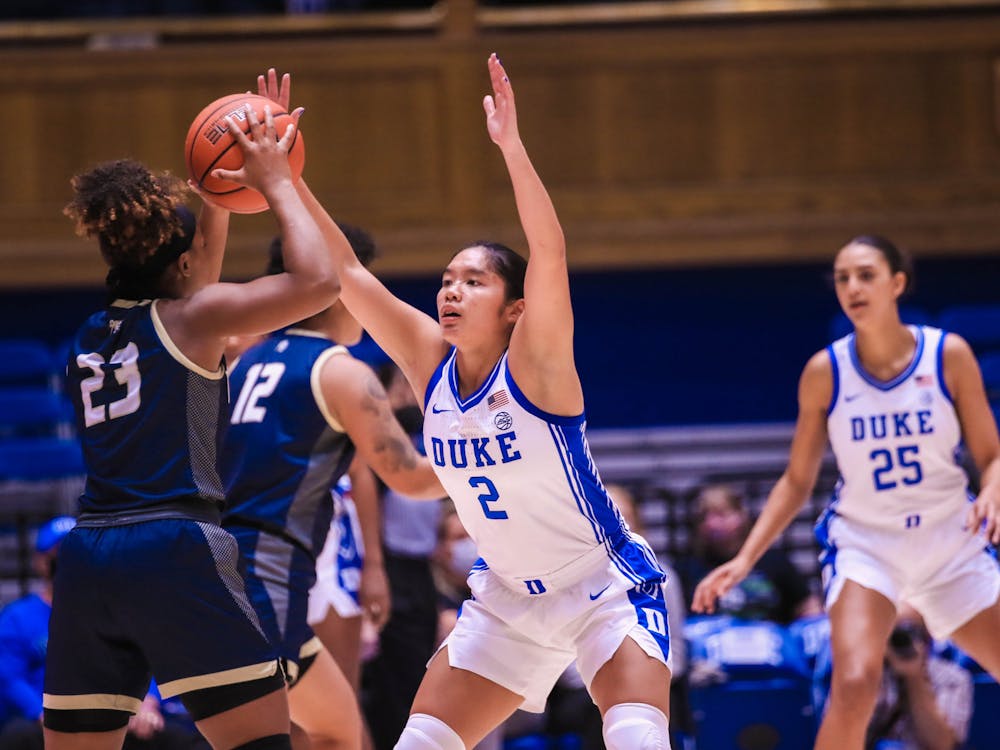To read Elena Karas' point, counterpoint, click here.
Duke comes into the 2021-22 season with a schematic tabula rasa. The team is new, the lineups are new, the personnel is new.
Two things remain the same from last year, however: the coaching staff and the style of roster construction. And the Blue Devil offense worked well in its limited time last year, so why not run it back?
Last season, Lawson and company's offense was notable for moving previous low-block-mainstay Jade Williams to the elbow. Rewards were reaped, as split cuts carved up opposing perimeter defense. Between Williams and her sometimes-backup, sometimes-miscast-as-a-power-forward teammate Onome Akinbode-James not being especially good as back-to-the-basket scorers, and collegiate defenses generally being better inside the paint than out in space, this greatly catalyzed the Duke offense.
The practice of using bigs as offensive hubs at the elbow is the key to the Princeton offense, which lifts its frontcourt players in many sets to act as passers, so that guards and wings can screen for each other and make split cuts. (A “split cut” being an off-ball screening action between the post-feeder and the next-closest perimeter player, who go in different directions afterwards.) It also allows for a lot of high-low actions between the lifted big and another big—or a big wing, if the team’s lineup has the fluidity at the three and four.
Stanford, with its glut of depth at wing and big, rode the Princeton to a national championship last year. Duke now wields a crowded, talented wing room; and though it isn’t quite as deep in the frontcourt, Williams and Imani Lewis are versatile talents, while Akinbode-James is a good high-low player, and Amaya Finklea-Guity emphasized passing in her offseason workouts.
Backcourt playmaking is one of few obvious weaknesses among the Blue Devils, and re-emphasizing elbow sets adds another player for defenses to have to account for in offensive facilitation.
“But!” the critics say, “The Princeton offense is slow!”
“Hold on!” the sceptics roar. “The Princeton offense is only a halfcourt scheme!”
“Wait!” the haters exclaim, “The Princeton offense will de-emphasize Duke’s backcourt athleticism!”
To them I say, “Have you forgotten about transition offense?” Because I have not.
The Blue Devils should be complimenting that halfcourt offense with a strong weight placed on transition scoring. If Duke runs out a great rebounding frontcourt duo like Akinbode-James and Lewis, then its backcourt can run off rebounds and get into fast breaks. If the Blue Devils are running smaller with Elizabeth Balogun, Lexi Gordon or Nyah Green, then they ought to run a defensive version of the “tagging-up” system of offensive rebounding, and get running as soon as the ball falls to a Blue Devil.
Hell, if a Duke big is under the rim during an opponent’s made basket, they should take it out and inbound it as quickly as possible while their teammates get downcourt.
And in that transition offense, the Blue Devils should get the ball ahead to a wing or big, and get into pistol action immediately. Pistol sets, born of Phil Jackson’s triangle offense—which the Chicago Bulls and Los Angeles Lakers ran for 11 NBA Championships—are transition sets that involve three players, with a backcourt player in the corner, a wing coming downhill from the slot, and a big around the elbow/slot area.
Duke has run Chicagos (where the wing sets a screen at the corner, and the other backcourt player comes up to the big for a dribble-handoff) galore last season and in its exhibition last Thursday—and they make a lot of sense for its personnel. It gets wings relocating, it gets guards automatically going downhill and it gets a big operating near the elbow for a perfect transition into the Princeton halfcourt if the pistol action gets turned away.
Sometimes, the more things change, the more they ought to stay the same.
Get The Chronicle straight to your inbox
Signup for our weekly newsletter. Cancel at any time.

